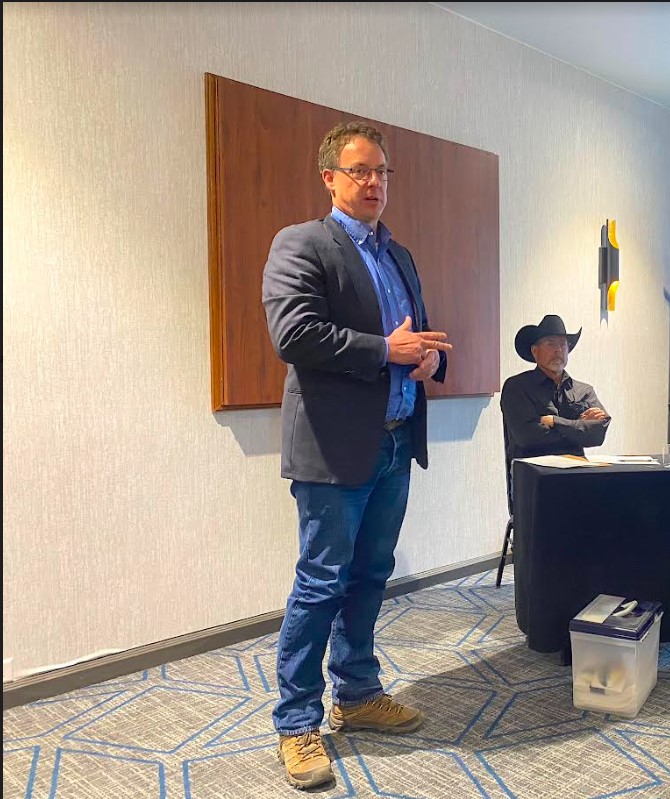Wolverines, wolves, chickens and cougars: Oh, my

It was standing room only meeting June 24, 2024, at the Marriott Hotel in Colorado Springs, as the Colorado Cattlemen’s Association kicked off their 157th Annual Convention with a special “Wildlife Resources” session, exclusively devoted to wildlife and its impact on Colorado livestock producers. This meeting was chaired by Lenny Klinglesmith, a well-known rancher from Rio Blanco County, with guest speakers from Colorado Parks and Wildlife, the U.S. Fish and Wildlife Service, Colorado Department of Agriculture and from the “Colorado’s Wildlife Deserve Better” coalition.
A lot of information was packed into two hours, and there were multiple hard-hitting questions from the audience. Klinglesmith set the ground rules early on — calling for a respectful exchange of ideas and information, and his lead was followed by all in attendance.

CPW Director Jeff Davis thanked the group for attending and discussed the importance of himself and his employees doing their best to understand and provide opportunities to help livestock producers. He recounted being told directly that “we trust your people, but we don’t trust you,” and he gave assurances that he will continue to try to build trust, and promised that he will “keep showing up.” He briefly discussed measures recently approved at the CPW Commissioners’ meeting in Winter Park. These dealt with wolf attacks on livestock and working dogs; depredation permits in the setting of pooled grazing; chronic depredation permits; the use of artificial light and night vision devices for lethal control (beginning Aug. 1), and how bison will now be classified as livestock and will be covered by these initiatives.
ESA AND WOLVES
Leading off the panel was Scott Becker, a regional wolf coordinator with the USFWS. He was a Technical Working Group member and former statewide wolf specialist for the Washington Department of Fish and Wildlife.
He attended remotely and talked about the Endangered Species Act and how it applies to wolves. He then presented a series of maps showing a complex management strategy, in which some wolves are covered by the ESA; some are delisted; and others are part of a state-sponsored, nonessential experimental population, like in Colorado. He said that Colorado officially has a population of 11 wolves, and he estimates that another four to six were added from the recent litter reported in Grand County. He also said that Arizona, New Mexico, Utah and Colorado have a memorandum of understanding in place, with the agreement allowing these states to legally capture and transport wolves back to Colorado,
if they stray over state lines.
Becker acknowledged concerns that wolves from Colorado could migrate into the current range of Mexican wolves (the rarest subspecies of gray wolf in North America), potentially causing conflict and dilution of their DNA pool. A question was asked about the Great Lakes wolf that was caught in a legal trap in Elbert County this past April.
He said that it was “a shock to all of us,” but not unheard of, as these wolves have migrated to
the Dakotas, Nebraska and south-central Kansas in the past. He also mentioned that it was
more likely that wolves would migrate in from the east, as opposed to coming down from the
Northern Rockies. There was no suggestion that this wolf had been anyone’s pet, as had been mentioned in previous reports.
Finally, he was asked about how chronic depredation should be defined in Colorado. He said that the USFWS did not have any comment on this, and has no control over the CPW’s definition, but the USFWS defines chronic depredation as two incidents within a calendar year, but that does not automatically trigger a lethal take.

NEXT WOLVERINES
Next, a CPW wildlife research scientist, Jake Ivan, discussed the upcoming introduction of wolverines into Colorado that was mandated by SB 24–171. Wolverines are the world’s largest terrestrial weasel, weighing between 15 and 40 pounds, and they were extirpated from Colorado in 1919. They have large territories and are efficient scavengers, but will also prey on small to medium-size animals, including marmots. They breed in the summer and have litters of two to four kits in the February/March timeframe. Colorado has approximately 20% of the estimated wolverine-appropriate habitat in the lower 48 states, and that was the impetus for their introduction. There are approximately 300 to 400 wolverines in Washington, Idaho, Montana and Wyoming, and the eventual goal in Colorado is a population of about 140. This will be achieved by introducing 15 animals per year over the first three years, and the wolverines will be sourced from either Alaska or Canada, with all the releases done on the Western Slope.
Ivan shared that there have been only two documented episodes of livestock depredations by wolverines in the lower 48 states: one in the late 1990s involving sheep in Wyoming, and another in 2022 in Utah, in which four sheep were killed and 14 were wounded. There have not been any reports of cattle depredations, however. A question was raised regarding avalanche control, and whether it could be hindered by federal land-use restrictions, because wolverines live in high-altitude environments. He did not foresee any restrictions, but acknowledged that federal agencies, such as the U.S. Forest Service, would have the final say on this.

Next up was Ray Aberle, the CPW private lands program manager, first speaking about the CPW’s five-year, big game season structure planning, including the loss of over-the-counter archery tags for non-residents. After this, the lesser prairie chicken (LPC) was discussed, specifically its relisting as a threatened species in Colorado in 2022. He mentioned the habitat impacts of the oil and gas industry, agriculture, land development as well as drought, while emphasizing the importance of “generational grasslands,” and a focus on voluntary habitat leasing and enhancements. Finally, he discussed how to get a management plan in place, in order to get exemptions to permit continued agricultural operations while remaining aware of the requirements for LPC habitat preservation.
The last 45 minutes were set aside for a discussion of the wolf introduction project that saw 10 Oregon wolves released into Colorado in December 2023.
Aberle went on to discuss that new wildlife conflict coordinator positions will be filled in the southwest and northeast regions soon, and will be filled in the southeast region a little later. Senior CPW staff has also planned fact-finding trips to Routt and El Paso counties to learn more about the experiences of ranchers in these areas. There were questions about depredation claims being paid on livestock and dogs, and one member of the audience asked: “Why does the CPW only bring in animals that kill things — can’t we bring in different species of turkeys and quail instead?”
LIVESTOCK DEPREDATION
Aberle emphasized the importance of keeping detailed records on livestock, so that their value could be accurately assessed later, if there was a depredation incident. He said that the CPW has pledged to redact the names of livestock producers who receive payments, but acknowledged that outside groups could still file lawsuits to have these names revealed, a statement that did not inspire much confidence from attendees.
Adam Baca, the CPW wolf conflict coordinator based in Jackson County, reported on the deployment of non-lethal deterrents, including foxlights and fladry, and claimed that “everyone we have partnered with has not had losses.”
Mark Truax, representing “Colorado’s Wildlife Deserve Better” spoke briefly about the Initiative 91 petition drive. This proposes to put a referendum on the ballot next November to ask Coloradans to vote on a ban on the hunting and trapping of mountain lions, bobcats and lynx, none of which are endangered or threatened. He discussed that organizations from outside the state are helping fund this, including Carole Baskin (Big Cat Rescue) and the Humane Society of the United States.
The audience was attentive and respectful, but obviously frustrated with the forced introduction of wolves that have wrought havoc with ranchers in Jackson, Grand and Routt counties. A Mesa County rancher voiced her concerns that “since 2017, there are 19,000 fewer head of cattle here, and some ranchers are saying that it’s easier to lease their land for hunting, than to try to raise livestock.” Others expressed concern that the news media is only focusing on compensation and not talking about the real toll that these losses take on livestock producers with regard to their mental and physical health, and their finances. Some felt that the once-noble image of the “hard-working rancher” has been tarnished over the past eight years, and there were concerns that members of the press have been complicit in this. There was agreement among all attendees that the CPW will cease to exist if livestock production
ceases, and that maintaining wildlife habitat is on the shoulders of ranchers who must be supported by the CPW.
Klinglesmith closed by saying that there are people and groups out there that are trying to take wildlife messaging out of the hands of the CPW, which has been “taking a beating” lately. He discussed the good relationship that most ranchers have had with the CPW over many years, and that political forces as well as lobbying groups and other interests, from both inside and outside of Colorado, are trying to drive a wedge between livestock producers and the CPW. He cautioned that we must not play into this plan, stating, “the CPW director is not the enemy here.”







